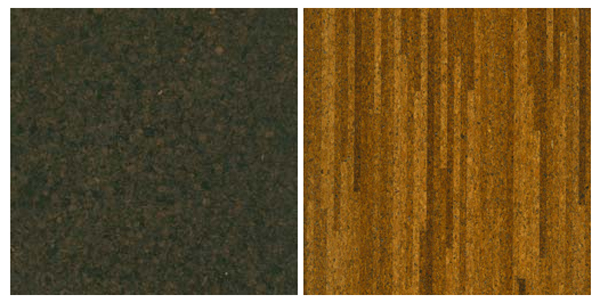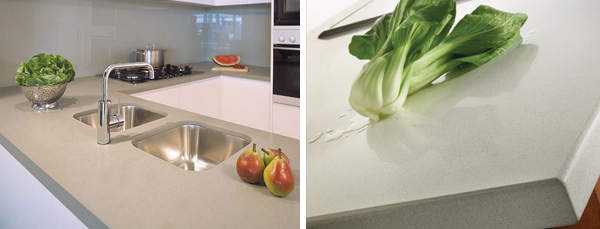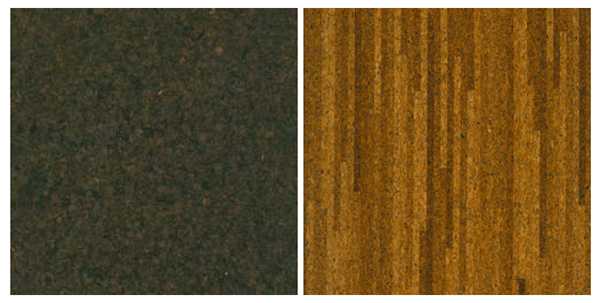There are two major material decisions that we still haven’t finalized: our countertops and our flooring. I know, I know…we talked about cork here and here, and completely had our minds made up here, but as things evolve we are rethinking our flooring one more time. Bottom line – we still love cork. But the two major considerations in the type of cork have changed. #1. We now have a fancy, perfectly level subfloor throughout the whole space. This means we could do a glue down tile rather than a floating system. The advantage? The glue down tile is a through-body product, meaning it’s the same color all the way through (the plank, floating system is a thin veneer over a natural color cork). Which brings us to consideration #2. We have a large dog. While our earlier cork test was mostly a success, there was one event that became cause for concern. One evening, in a rare burst of golden retriever energy, Bailey leapt off the bed and skidded across the cork plank sample that we had set up at the bedroom door way. His excessively furry paws couldn’t stop the claw action. The result was a 6″ gauge that wasn’t too deep, but enough to expose the natural color cork below. We also knew that creating a bigger, more open space would only encourage such behavior.
So, even though we loved the color and pattern of our first choice, we’re back to cork tiles and have narrowed it down to two choices:

On the left we have a dark brown cork that is created from a steaming process (since cork does not naturally occur in this color). We love that it is different and it seems to go with our other color palette. We also love the “strip” pattern on the right, which is fabricated from scraps of other cork to achieve the variation in golden brown hues. The patterned option involves more labor to produce, so it’s a bit more expensive – but because we’ll be covering most of our floors, we want to make the right choice! Also, both options can be ordered with a wax finish (which we’ve found is the way to go since it allows spot repairs without having to refinish the whole floor).
Now on to the next challenge – back in January we talked about our top two counter choices. Since then, we have secretly fallen for the quartz product (below, left), which would be about $60-$70/SF (installed). This quartz comes in either a super snow white or a warmer off-white hue – neither of which are a perfect fit with the rest of our palette. Then, at our post-IKEA trip to Ecohaus last weekend we saw this. Eco quartz countertops are made with 75% recycled product and bound by corn resin! They’re also one of the few green residential products I’ve seen that is Cradle To Cradle certified. Best of all, their white color, “polar cap” (below, right) has flecks of blue-gray that would fit right in with our new cabinets (we would do a simple 2 cm square edge though, not the built-up version shown in the photo). The downside – it’s expensive. Very expensive…as in, $90/SF (installed) expensive. Our number one sustainable goal with the countertops has been to pick something that is both durable and a color/pattern that we could be happy with long term. Recycled content and eco-friendly resins would be icing on the cake, but we’ll have to weigh the added costs with our overall budget goals. Like the sink and faucet, we recognize the countertops will get a lot of daily action so making the right decision will be key.

So now it’s time to take it to the people. Darker or lighter cork? More affordable quartz or super sustainable, crazy expensive quartz? Or…are there still more options yet to consider? Now is the time!

We installed Silestone’s white quartz with flecks (Blanco Maple) and we love it and what the flecks do for the look. I wouldn’t beat yourself up if you decide to go with the cheaper option since any quartz is still recycling on a level. Good luck!
We used glue down cork in our bathroom for many of the same reasons. We also worried about water getting in the laminate and the plank swelling etc. It has been in for 2 years or so with no problems. A couple of tips: 1. Use the glue sparingly. I applied it a bit thick which caused the planks to shift a little leading to imperfect seams and 2. Tape your seams to help avoid problem number 1. We did the project on the fly without thinking things through…
I am a huge fan of dark floors. It just feels right, visually – you know? My vote would be that lovely dark tile.
As for the countertops – what kind of corn is used to produce the resin for the Eco Quartz? If it’s genetically modified or factory produced corn – not sustainable at all… I’d argue that any corn not produced on an organic farm with heirloom seeds isn’t eco friendly. (Kind of one of my pet-peeves.) But – if it’s free of evil corn, and you’ll enjoy that product more for years and years, then the upgrade is likely worth it.
Love your blog! I’m an architect married to an architect, looking for a project house to buy – so I can totally relate! Love what you’ve done with your house.
Thanks Nicole,
I hear you on the corn issue (don’t get me started on those high fructose corn syrup commercials!). I actually just discovered that Eco is made by the same people that make Silestone. I still have some more research to do but it may come down to a pro/con list. =)
Good luck finding a house! It’s an adventure!
Thanks for the tip…I completely forgot about Silestone. Just checked out their website and noticed they’re also owned by Cosentino (the makers of Eco). Maybe I’ll snag a few samples this weekend…
Yeah, I don’t want government subsidized corn countertops 🙂 thanks Nicole
I like the lighter cork and the countertop with the flecks. I have expensive tastes, it seems. : )
you guys are gonna mess around and have this thing done before your deadline! nice work! (figured I would go ahead and jenks it for you)
I spent my whole weekend trying to get my Ikea kitchen finished before the sale ended. We also got a quote from Precision Countertops in Ikea for the Eco Polar Cap by Silestone. It was eligible for the same 20% off incentive-how did you guys miss it? Doh! Non the less, Precision has it at 82 bucks a sq ft installed without the sale.
My uncle may end up doing the install for us, and he is a big advocate of natural stone. I have say, after walking the aisles of the slab wharehouses I like the natural stone more and more. I think we are going with the polar cap on our wall counter top, and some natural material for our log island. Shockingly, a lot of the marble is cheaper than the fake stuff.
My advise-look at ecohause-buy somewhere else, they have lost their minds on pricing. There are so many laid of fabricators around that if you find one you like they are likely to get you a great deal on any product you like.
And I say that the 75% POST consumer content and lack of petroleum based resin makes it a greener choice despite the evil corn.
My two cents,
Anna
Nice score Anna! Our IKEA only had Caeserstone counters…I wonder if it varies from store to store?
I’m finding that a lot of stone (both natural and engineered) products come from far, far away so we’re also trying to factor that into our decision making process. And then there’s the issue of responsible quarry management(!). So now we’re also looking at some recycled glass/cement options. Decisions, decisions!
Unless you went all the way to Portland to go to Ikea, we have the same one. Precision Countertops in Kent is the rep at the Tuckwilla Ikea, I assume that is the one you guys went to. They sell Eco Quartz for 82.00 a sq ft.
Crazy, we must have totally missed it! And we stood right there next to the Precision display for about 20 minutes while they put together our order! Oh well…I should give them a call and get a quote anyway. I also found out that Lowe’s carries Eco quartz but for about the same price/sf.
[…] September 9, 2010 by chezerbey We first talked about counters way back in January. By April, we had narrowed it down to quartz. In May, we put together this materials palette to see how […]
[…] tips to add. (You can also read more about our cork selection process here, here, here and here.) So far, we’re really pleased with how it turned out. In fact, we have (as of today) […]